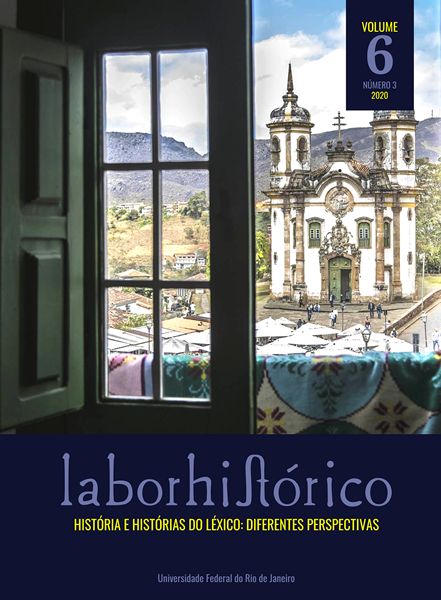Ideophones and realia in a Santome/Portuguese bilingual dictionary
DOI:
https://doi.org/10.24206/lh.v6i3.33700Keywords:
Ideophones. Realia. Santome. Portuguese. Lexicography.Abstract
In this work, we discuss how Araujo & Hagemeijer’s Santome/Portuguese bilingual dictionary (ARAUJO; HAGEMEIJER, 2013) defines and describes ideophones and realia entries. We show that ideophones were listed individually along with their collocation counterparts. Realia entries (words and expressions for culture-specific items) were presented in their Santomean forms, followed by a description of their endemic specificities. Many realia items from Santome can also be found in Portuguese. We conclude that the authors contribute to the lexicographic record of ideophones, lexical items that did not exist in Portuguese, but relevant to the language and culture of Santome. On the other hand, with the documentation of realia entries, they collaborate for the validation of lexical units (originated in Santome) in the local vernacular variety of São Tomé and Príncipe’s Portuguese, a common historical practice in Portuguese lexicography.
Downloads
References
AGOSTINHO, A. L.; ARAUJO, G. A. Dicionário Lung’Ie/Português. São Paulo: Humanitas, in press.
ARAUJO, G. A. Ideofones na língua sãotomense. Papia, v. 19, p. 23–37, 2009.
ARAUJO, G. A.; HAGEMEIJER, T. Dicionário livre do santome-português. São Paulo: Hedra, 2013.
AUROUX, S. A revolução tecnológica da gramatização. Campinas: Editora da Unicamp, 1992.
BACELAR DO NASCIMENTO, M. F. Comparable Corpora and Lexical Variation in the African Varieties of Portuguese. Alfa, v. 50.2, p. 189–204, 2006.
BACELAR DO NASCIMENTO, M. F. Processos de Lexicalização. In: RAPOSO, E.; BACELAR DO NASCIMENTO, M. F.; MOTA, M. A.; LUÍSA SEGURA, A. M. (eds). Gramática do Português. Lisboa: Fundação Calouste Gulbenkian, 2013. p. 215–246.
BACELAR DO NASCIMENTO, M. F.; MENDES, A.; ANTUNES, S. Typologies of MultiWord Expressions Revisited: A Corpus-driven Approach. In: KAWAGUCHI, Y.; ZAIMA, S.; TAKAGAKI, T. (eds). Spoken Language Corpus and Linguistic Informatics. Amsterdam: John Benjamins, v. 5, 2006. p. 227–244.
BANDEIRA, M.; ARAUJO, G. A.; FINBOW, T. The Gulf of Guinea Proto-Creole and its Daughter Languages: from Liquid Consonants to Complex Onsets and Vowel Lengthening. Manuscrito: Universidade de São Paulo, 2019.
BARTENS, A. Ideophones and Sound Symbolism in Atlantic Creoles. Helsinki: Academia Scientiarum Fennica, 2000.
BLUTEAU, R. Vocabulário portuguez e latino, áulico, anatômico, architectonico etc. Coimbra: Collegio das Artes da Companhia de Jesus, 1712–1728. http://www.brasiliana.usp.br/en/dicionario/edicao/1. Accessed: 05 May, 2019.
BRINDLE, J. A. Aspects of the Chakali language. PhD thesis, Norges Teknisk-Naturvitenskapelige Universitet (NTNU), 2011.
BRINDLE, J. A. A dictionary and grammatical outline of Chakali. Berlin: Language Science Press, 2017. DOI: 10.5281/zenodo.344813
CERÍACO, L. M. P.; MARQUES, M. P.; SCHMITZ, A.; BAUER, A. M. The “Cobra-preta” of São Tomé Island, Gulf of Guinea, Is a New Species of Naja Laurenti 1768 (Squamata: Elapidae). Zootaxa, v. 4324.1, p. 21–41, 2017. https://doi.org/10.11646/zootaxa.4324.1.7.
COSTA, P. P. Ideofones em Santome. Dissertação de mestrado, Universidade de Lisboa, 2017.
DOKE, C. M. Bantu Linguistic Terminology. London: Longmans/Green, 1935.
EBERHARD, D. M.; SIMONS, G. F.; FENNIG; C. D. (eds.). Ethnologue: Languages of the World. Twenty-second edition. Dallas, Texas: SIL International, 2019.
FERRAZ, L. I. The Creole of São Tomé. Johannesburg: Witwatersrand University Press, 1979.
FRANKENBERG-GARCIA, A. The Lexicography of Portuguese. In: HANKS, P.; DE SCHRYVER, G.-M. (eds). International Handbook of Modern Lexis and Lexicography. Berlin/Heidelberg: Springer, 2017. p. 1-11. https://doi.org/10.1007/978-3-642-45369-4_66-1.
FRIESEN, D. A grammar of Moloko. Berlin: Language Science Press, 2016.
HAGEMEIJER, T. As línguas de São Tomé e Príncipe. Revista de Crioulos de Base Lexical Portuguesa e Espanhola, v.1, p. 1–29, 2009.
HARTMAN, R. R. K.; JAMES, G. Dictionary of lexicography. London: Routledge, 2001.
INE. 2012. Instituto Nacional de Estatística (INE): São Tomé e Príncipe em Números. São Tomé: 2001. http://http://www.ine.st/2012.html. Accessed: 18 May 2019.
MARTINS, V. P. S. Estratégias de compreensão de expressões idiomáticas por não nativos do português brasileiro. Tese de doutorado, Universidade Federal do Ceará, 2013.
NADAL, L. L. Los culturemas: ¿unidades lingüísticas, ideológicas o culturales? Language Design, v. 11, p. 93–120, 2009.
OGILVIE, S. Lexicography and Endangered Languages: What Can Europe Learn from the Rest of the World?. In: DYKSTRA, A.; SCHOONHEIM, T. (eds). XIV EURALEX Proceedings of the International Congress. Leeuwarden/Ljouwert: Fryske Akademy-Afûk, 2010. p. 27–46.
PINHEIRO, M. G. Descrição e análise dos culturemas do português brasileiro. Dissertação de mestrado. UFC, 2018.
STIEGLER, B. The Decadence of Industrial Democracies. Disbelief and Discredit, v. 1. Translated by D. ROSS and S. ARNOLD. Malden: Polity Press, 2011.
VLAKHOV, S.; FLORIN, S. Neperovodimoe v perevode. Realii. Masterstvo perevoda, v. 6, 1969, Moskva: Sovetskij pisatel (1970), p. 432–456. Print.
VOELTZ, E. Toward the Syntax of Ideophone: Zulu. In: KIM, C.; STAKLKE, H. (eds). Papers in African Linguistics. Edmonton: Champaign, 1971. p. 141–152.
XATARA, C. M.; SECO, M. Culturemas em contraste: idiomatismos do português brasileiro e europeu. Revista Domínios de Lingu@gem, v. 8.1, p. 502–519, 2014. https://doi.org/10.14393/DL15-v8n1a2014-29.
YAKPO, K. A grammar of Pichi. PhD dissertation, Radboud University Nijmegen, 2009. http://hdl.handle.net/2066/79407. Accessed: 06 Feb 2019.
YAKPO, K. A Grammar of Pichi. Berlin: Language Science Press, 2019. DOI: https://doi.org/10.5281/zenodo.2546450.
WESTERMANN, D. Grammatik der Ewe Sprache. Berlin: D. Reimer, 1907.
Downloads
Published
Issue
Section
License
Authors who publish with this journal agree to the following:
a. The authors hold copyright of the published papers; authors are the sole responsible party for published papers content; the published paper is licensed under a Creative Commons Attribution-NonCommercial 4.0 International License which allows the sharing of the publication as long as there is acknowledgement of authorship and publishing by Revista LaborHistórico.
b. Authors should seek previous permission from the journal in order to publish their articles as book chapters. Such publications should acknowledge first publishing by LaborHistórico.
c. Authors may publish and distribute their papers (for example, at institutional repositories, author's sites) at any time during or after the editorial process by Revista LaborHistórico.


